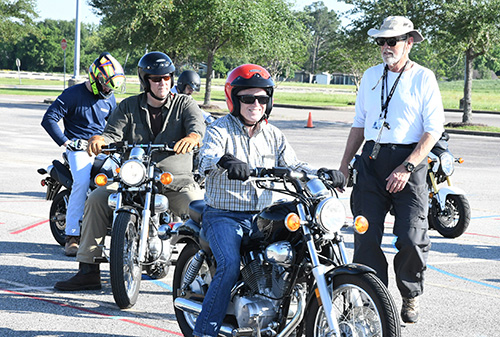Is it time to cross motorcycle license off your bucket list?
A youngster in the hippie era, John Jackson still remembers the image of bikers then: leather-clad, rough, and rebellious. A lot has changed.
"In the 70s, you saw hard-core people," Jackson said. "Now you see professionals riding motorcycles."
Not only does the San Jacinto College Continuing and Professional Development motorcycle instructor want to change the biker stereotype. He also wants to appeal to senior citizens who have dreamed of riding into the sunset on a motorcycle and now have time to learn.
All ages welcome
This spring, CPD will offer eight sessions of the motorcycle basic rider course at the South Campus for community members to get their Class M license. Enrollment is eight students per class.
Think motorcycles are for the younger crowd? While some 20-somethings enroll looking for a cheaper transportation option, Jackson has taught his share of senior citizens looking to cross off a bucket list item.
Jackson started riding dirt bikes at 13 and street bikes at 20. He got certified to teach motorcycle rider courses in 2006. At 56, he still enjoys both riding and teaching.
"I like the challenge — want to help grow the motorcycle community," he said. "The neatest thing about being a motorcycle instructor is you meet people from all walks and professions."
Class M 101
San Jac's course takes place in 15 hours over a Saturday and Sunday. Those two days include five hours of classroom instruction, bike exercises, and occasional breaks.
Classroom activities introduce the skill set a rider needs — from critical thinking to safe decision making. The riding sessions include 14 range exercises in the parking lot using provided motorcycles. Students practice basic control, including clutch and throttle coordination, straight-line riding, stopping, turning, and shifting.
In Texas, motorcycle license seekers must take an in-person class and pass written and skills tests.* The San Jac class includes both tests, and passing students receive a certificate to take to the Texas Department of Motor Vehicles to get the Class M endorsement added to their driver's license — about a $16 fee.
While many students pass the class, Jackson said the biggest issues happen when people can't balance on the motorcycle, manage the clutch, or maintain stamina for the physical demands of a motorcycle. Or they don't take Texas heat into account.
"Conditions outdoors can really affect you," he said.
If you have an underlying health condition, choose a spring or fall class over summer.
No substitute for safety
Who is the ideal candidate for a motorcycle? Someone who commits to safety, Jackson said.
"It's more dangerous than driving a four-wheel vehicle," he said.
Think about it: In a vehicle, the engine, trunk, and door serve as buffers between you and another driver. In a motorcycle, that cushion doesn't exist.
Riders also must be aware of road hazards and unfavorable driving conditions — from potholes and texting drivers who drift across lanes to rain and sizzling Texas heat combining with bike heat.
Road trips and riding buddies
Despite road hazards, Jackson says nothing beats the experience on two wheels.
"I think it's very relaxing," he said. "Most people say that when they talk to me: 'I have a stressful week. Then I get on my motorcycle on the weekend.'"
The community aspect is also a draw. Some riders have standing weekend breakfast rides: Every Saturday they hit the road together to try eggs, bacon, and biscuits at a new hole-in-the-wall. If you're a motorcyclist, you're never without a riding buddy, Jackson said.
"That's the neat part about it," he said. "You can go to a store that sells motorcycle apparel and exchange numbers, and next thing you know, you have a new riding friend."
*Note: Anyone without a driver's license or under 18 must still take a DMV road test.
Long-sleeved shirts and pants Over-the-ankle leather shoes or boots with heels Gloves Glasses or face shields Helmets (because of COVID-19, you may have to bring your own at this time)Get Your Class M
Students must wear/bring:

